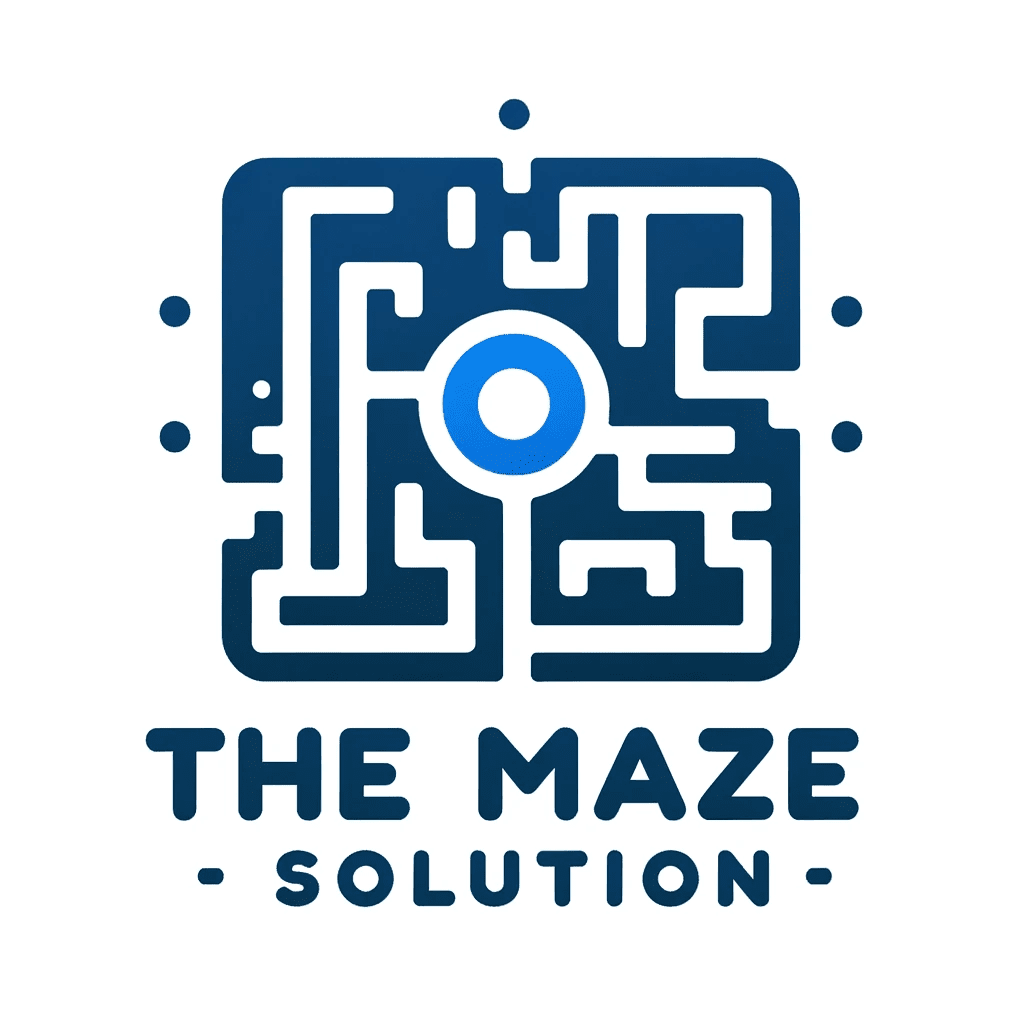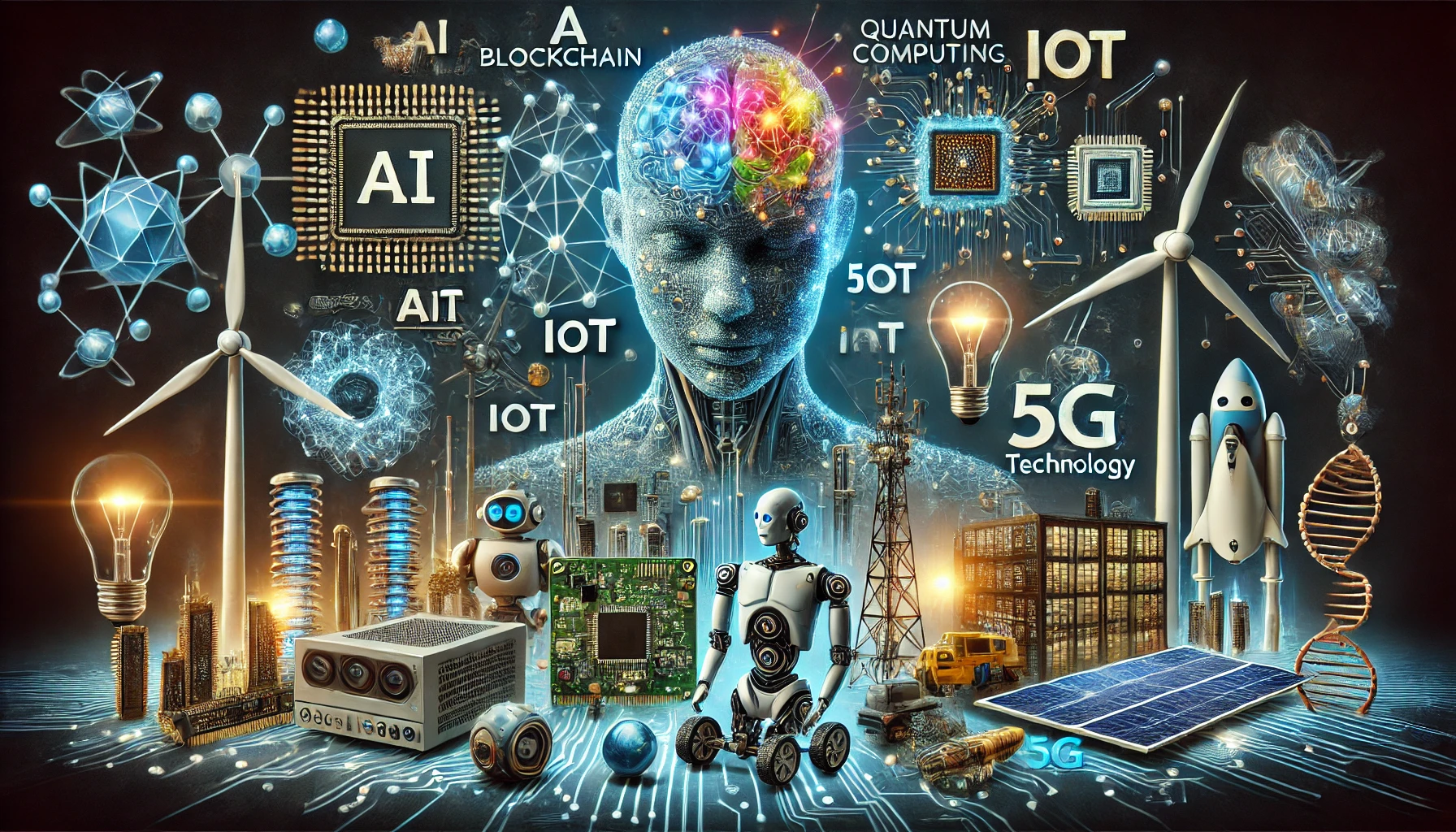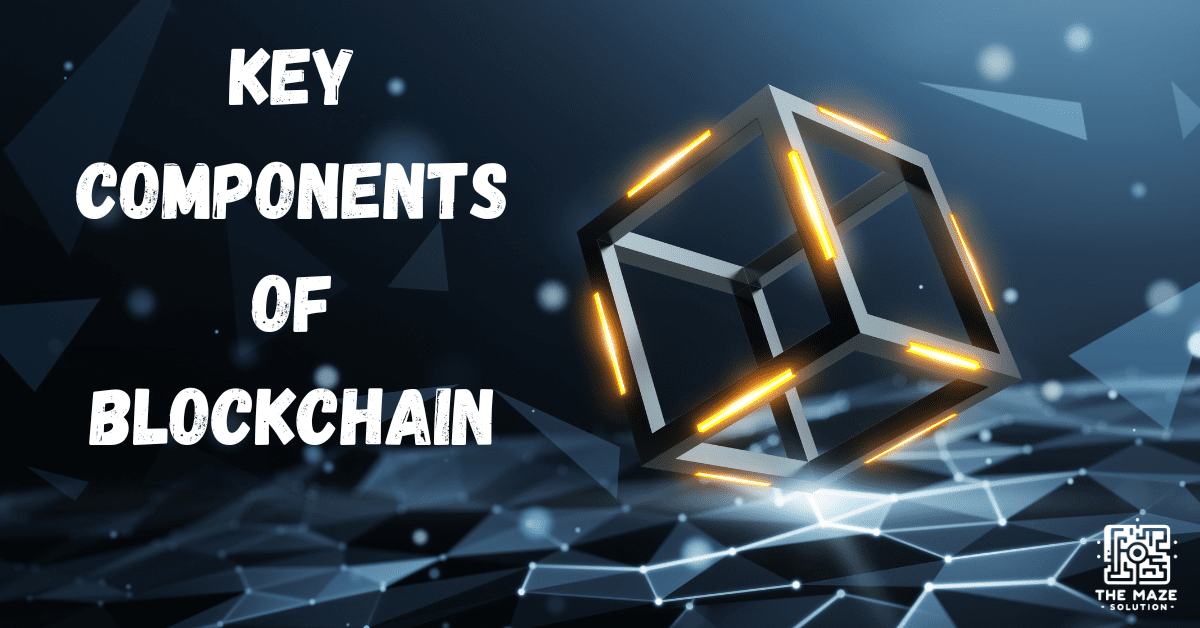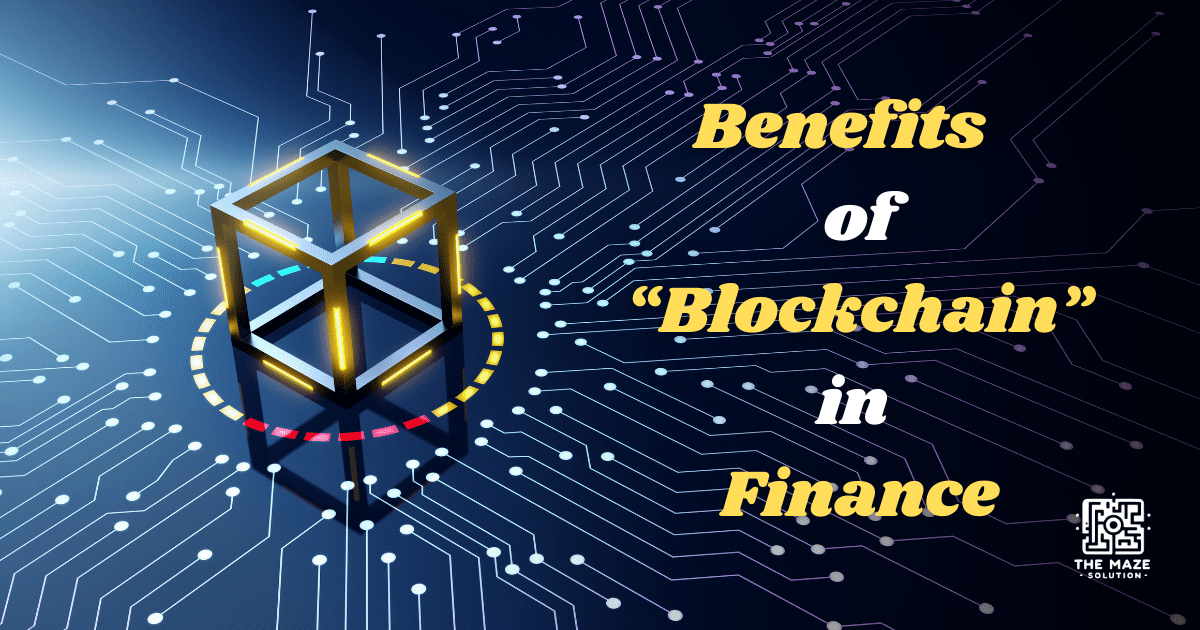Blockchain vs Traditional Databases: A Comprehensive Comparison
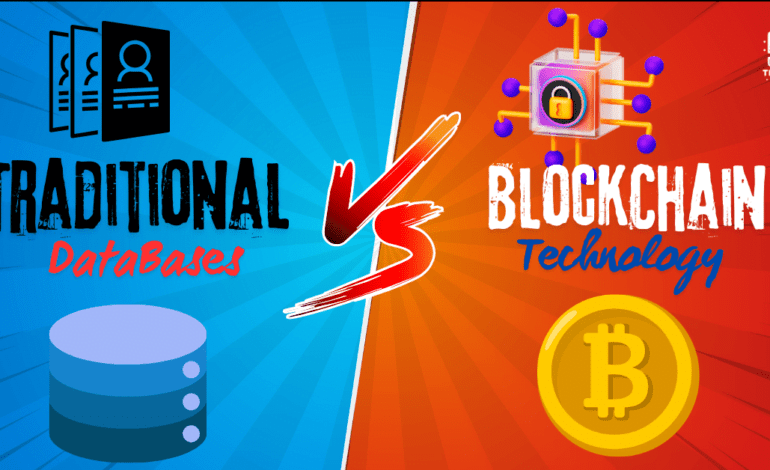
In today’s digital age, data reigns supreme. From businesses making informed decisions to tech enthusiasts tinkering with new applications, the way we store and manage data is pivotal. But with so many options out there, how do you choose the right one? This comprehensive guide will break down the key differences between blockchain vs traditional databases, helping you make an informed decision.
Understanding Blockchain Technology
What is Blockchain Technology ?
Blockchain Technology is a decentralized ledger technology that records transactions across multiple computers. Initially known for its role in powering cryptocurrencies like Bitcoin, blockchain has evolved into a versatile tool with applications ranging from supply chain management to voting systems.
The idea of blockchain was first conceived by an unknown person or group of people using the pseudonym Satoshi Nakamoto in 2008. Since then, it has undergone significant advancements, transforming from a niche technology to a mainstream solution.
Key Features of Blockchain
Decentralization
Unlike traditional databases, which are controlled by a single entity, blockchain operates on a decentralized network. This means no single authority has control over the entire database, reducing the risk of centralized failures.
Transparency
Every transaction on a blockchain is recorded and visible to all participants in the network. This level of transparency fosters trust among users, as everyone can verify the transactions independently.
Immutability
Once data is written to a blockchain, it cannot be altered or deleted. This immutability ensures data integrity and makes blockchain a reliable source of truth.
Security
Blockchain Technology employs advanced cryptographic techniques to secure data. Each block is linked to the previous one using cryptographic hashes, making it nearly impossible to tamper with the data without being detected.
How Blockchain Works
Blockchain Structure
A blockchain consists of a series of blocks, each containing a list of transactions. These blocks are linked together in a chain, with each block referencing the hash of the previous one.
Consensus Mechanisms
Blockchain networks use consensus mechanisms to validate transactions. Popular methods include Proof of Work (PoW) and Proof of Stake (PoS), which ensure that all participants agree on the state of the blockchain.
Smart Contracts
Smart contracts are self-executing contracts with the terms of the agreement directly written into code. They automatically execute actions when predefined conditions are met, eliminating the need for intermediaries.
Blockchain vs Traditional databases
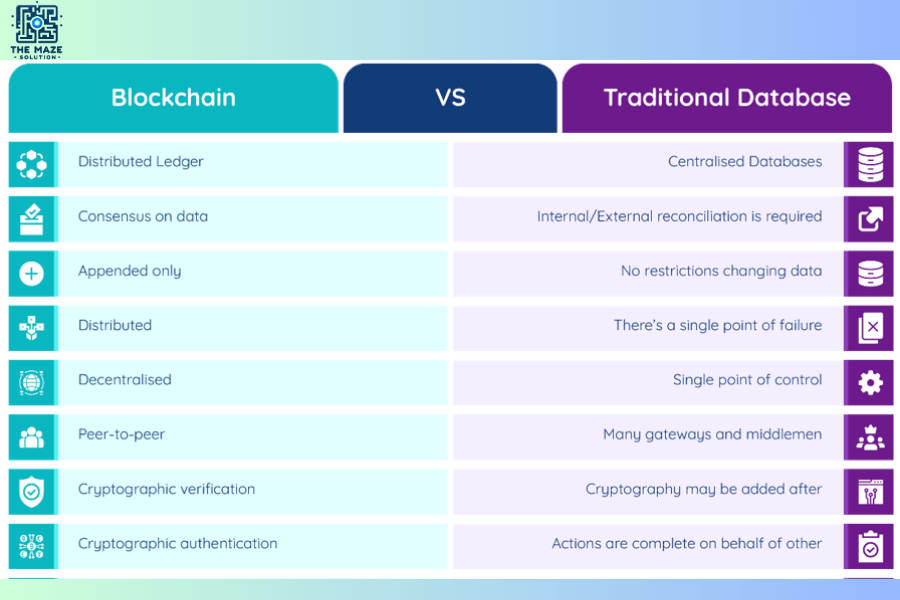
What are Traditional Databases?
Traditional databases have been the backbone of data storage and management for decades. They come in two main types:
Relational Databases (RDBMS)
These databases use tables to store data and establish relationships between them. Examples include MySQL, PostgreSQL, and Oracle.
Non-relational Databases (NoSQL)
These databases store data in formats other than tables, such as documents, key-value pairs, or graphs. Examples include MongoDB, Cassandra, and Redis.
Key Features of Traditional Databases
Centralization
Traditional databases are typically managed by a single organization or entity, providing centralized control over data access and management.
Data Integrity and ACID Properties
Relational databases adhere to ACID (Atomicity, Consistency, Isolation, Durability) properties, ensuring reliable transactions and data integrity.
Performance and Scalability
Traditional databases are optimized for high performance and scalability, capable of handling large volumes of data and concurrent users efficiently.
How Traditional Databases Work
Database Management Systems (DBMS)
Database Management Systems (DBMS) are software applications designed to interact with end-users, applications, and the database itself to capture and analyze data. The DBMS manages the data, the database engine, and the database schema to facilitate the organization and manipulation of data. Here are some key functions and features of DBMS:
- Data Storage and Retrieval: DBMS provides a systematic way to store and retrieve large amounts of data. It allows users to define, create, maintain, and control access to the database.
- Data Integrity and Security: DBMS ensures data integrity and security by enforcing rules and constraints. It controls access to data by providing authentication and authorization mechanisms.
- Data Management Tools: DBMS offers tools for managing databases, such as backup and recovery, performance tuning, and monitoring tools.
Examples of DBMS include:
- MySQL: An open-source relational database management system that uses SQL for querying and managing data. It is widely used for web applications and is known for its reliability and ease of use.
- MongoDB: A popular NoSQL database known for its flexibility and scalability. It stores data in a JSON-like format, making it easy to work with complex data structures.
SQL and NoSQL Databases
Traditional databases are categorized into two main types based on their data models: SQL and NoSQL databases.
- SQL Databases:
- Structure: SQL databases are relational databases that use tables to store data. Each table consists of rows and columns, with each row representing a record and each column representing a data attribute.
- Query Language: SQL databases use Structured Query Language (SQL) for defining, manipulating, and querying data. SQL is a powerful and standardized language that supports complex queries, joins, and transactions.
- ACID Properties: SQL databases adhere to ACID (Atomicity, Consistency, Isolation, Durability) properties, ensuring reliable transactions and maintaining data integrity.
- Examples: MySQL, PostgreSQL, Oracle Database, Microsoft SQL Server.
- NoSQL Databases:
- Structure: NoSQL databases are non-relational and can store data in various formats, including key-value pairs, document-oriented, column-family, and graph databases. This flexibility allows them to handle unstructured and semi-structured data efficiently.
- Query Language: NoSQL databases offer more flexible query options compared to SQL. They may use their own query languages or APIs for data manipulation.
- Scalability: NoSQL databases are designed to scale horizontally, making them suitable for large-scale, distributed applications.
- Examples: MongoDB (document-oriented), Redis (key-value store), Cassandra (column-family), Neo4j (graph database).
CRUD Operations
CRUD stands for Create, Read, Update, and Delete, which are the four basic operations supported by traditional databases. These operations allow users to manage data efficiently:
- Create:
- The Create operation inserts new data into the database. In SQL databases, this is done using the
INSERTstatement. In NoSQL databases, the method varies based on the database type. - Example (SQL):
INSERT INTO users (name, email) VALUES ('John Doe', '[email protected]'); - Example (NoSQL – MongoDB):
db.users.insertOne({ name: 'John Doe', email: '[email protected]' });
- The Create operation inserts new data into the database. In SQL databases, this is done using the
- Read:
- The Read operation retrieves data from the database. In SQL databases, this is done using the
SELECTstatement. NoSQL databases have their own methods for reading data. - Example (SQL):
SELECT * FROM users WHERE email = '[email protected]'; - Example (NoSQL – MongoDB):
db.users.find({ email: '[email protected]' });
- The Read operation retrieves data from the database. In SQL databases, this is done using the
- Update:
- The Update operation modifies existing data in the database. In SQL databases, this is done using the
UPDATEstatement. NoSQL databases provide different methods for updating documents or records. - Example (SQL):
UPDATE users SET name = 'Jane Doe' WHERE email = '[email protected]'; - Example (NoSQL – MongoDB):
db.users.updateOne({ email: '[email protected]' }, { $set: { name: 'Jane Doe' } });
- The Update operation modifies existing data in the database. In SQL databases, this is done using the
- Delete:
- The Delete operation removes data from the database. In SQL databases, this is done using the
DELETEstatement. NoSQL databases offer various methods for deleting documents or records. - Example (SQL):
DELETE FROM users WHERE email = '[email protected]'; - Example (NoSQL – MongoDB):
db.users.deleteOne({ email: '[email protected]' });
- The Delete operation removes data from the database. In SQL databases, this is done using the
These CRUD operations are fundamental to database management, enabling users to perform essential tasks such as adding new data, retrieving existing data, updating records, and removing unnecessary data. By supporting these operations, traditional databases facilitate efficient data management and ensure that applications can interact with the stored data effectively.
Blockchain vs Relational Databases
Data Storage and Management
Blockchain Data Storage vs Legacy Databases
blockchain technology stores data in blocks linked in a chain, whereas traditional databases use tables and rows. This structural difference results in unique advantages and challenges for each technology.
Data Structure
In a blockchain technology, each block contains a set of transactions and a reference to the previous block. In relational databases, data is organized in tables with rows and columns, allowing for complex queries and relationships.
Performance and Scalability
Transaction Speed and Throughput
Traditional databases generally offer higher transaction speeds and throughput compared to blockchain. Blockchain’s decentralized nature and consensus mechanisms can introduce latency.
Scalability Challenges
blockchain technology faces scalability issues due to the need for consensus across the network. Traditional databases can scale more easily by adding resources to the server.
Security and Privacy
Decentralized Ledgers vs Centralized Databases
Blockchain’s decentralized nature enhances security by reducing the risk of single points of failure. Traditional databases, while secure, can be vulnerable to attacks on the central authority.
Data Encryption and Privacy
Both blockchain technology and traditional databases employ encryption to protect data. However, blockchain’s transparency can pose privacy challenges, requiring additional measures to safeguard sensitive information.
Decentralized Ledgers vs Centralized Databases
Governance and Control
Centralized Control
Traditional databases are governed by a single entity, providing clear control over data access and management.
Decentralized Governance
Blockchain operates on a decentralized model, where control is distributed among network participants. This reduces the risk of manipulation and enhances trust.
Data Integrity and Immutability
Ensuring Data Integrity
Relational databases use ACID properties to maintain data integrity. Blockchain’s immutability ensures data remains unchanged once recorded, enhancing reliability.
Use Cases and Applications
Traditional Databases
Used in finance, healthcare, and e-commerce, traditional databases excel in applications requiring complex queries and transactional consistency.
Blockchain Technology
Blockchain is gaining traction in supply chain management, digital identity verification, and decentralized finance (DeFi) due to its transparency and security.
Blockchain Data Storage vs Legacy Databases
Cost and Resource Requirements
Infrastructure Costs
Traditional databases require robust infrastructure and maintenance. Blockchain networks, while decentralized, can be resource-intensive, especially in terms of energy consumption.
Flexibility and Customization
Customization Options
Traditional DBMS offers extensive customization through schema design and query optimization. Blockchain solutions, while flexible, may require significant development effort for customization.
Data Access and Retrieval
Querying Data
SQL databases provide powerful querying capabilities, enabling complex data retrieval. Blockchain’s data retrieval processes are less flexible, often requiring traversal of the entire chain.
Pros and Cons of Blockchain and Traditional Databases
Advantages of Blockchain Technology
Enhanced Security
Blockchain’s cryptographic security and decentralized nature reduce the risk of fraud and unauthorized access.
Trustless Transactions
Blockchain vs Relational Databases enables trustless transactions, where participants can interact without relying on a central authority.
Disadvantages of Blockchain Technology
Scalability Issues
Blockchain’s consensus mechanisms can limit scalability, making it less suitable for high-throughput applications.
High Energy Consumption
Blockchain networks, especially those using PoW, consume significant energy, raising environmental concerns.
Advantages of Traditional Databases
High Performance
Traditional databases offer high performance, capable of handling large volumes of data and concurrent users efficiently.
Established Standards
With decades of development, traditional databases have mature standards and best practices, ensuring reliability and support.
Disadvantages of Traditional Databases
Centralized Control
Centralized control can create single points of failure and vulnerabilities to attacks.
Potential for Data Manipulation
Central authorities can manipulate data, undermining trust and reliability.
Choosing the Right Solution
Factors to Consider
Business Requirements
Evaluate your business needs, including data sensitivity, security, and performance demands.
Data Sensitivity
Consider the sensitivity of your data and the level of security required.
Decision-Making Framework
Pros and Cons
Assess the advantages and disadvantages of each technology in the context of your specific use case.
Strategic Objectives
Align your choice of database technology with your strategic goals and long-term vision.
Future Trends and Developments
Innovations in Blockchain
Stay updated on advancements in blockchain technology, such as improved scalability solutions and energy-efficient consensus mechanisms.
Developments in Traditional Databases
Monitor innovations in traditional databases, including enhancements in performance, scalability, and data security.
Conclusion
In the grand showdown between blockchain vs traditional databases there is no one-size-fits-all winner. Each technology offers unique strengths and weaknesses, making them suitable for different applications. By understanding the nuances of both technologies, you can make an informed decision that aligns with your business needs and goals.
Remember, the choice of database technology is critical in shaping the efficiency, security, and scalability of your operations. Evaluate your requirements, consider the pros and cons, and stay informed about future developments to make the best choice for your organization.
Your thoughts and experiences matter to us! Share your insights in the comments and subscribe to our blog for more in-depth discussions on technology and databases.
